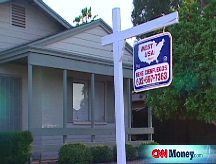Mesa, Ariz.: Poster child for foreclosure
The president chooses the Chicago Cubs' winter home - a city wracked by foreclosures - to unveil his mortgage-recovery plan.
 |
| An ariel view of Mesa, Ariz. |

| 30 yr fixed | 3.80% |
| 15 yr fixed | 3.20% |
| 5/1 ARM | 3.84% |
| 30 yr refi | 3.82% |
| 15 yr refi | 3.20% |
NEW YORK (CNNMoney.com) -- In Mesa, Ariz., President Obama picked an appropriate place to talk about the mortgage-default crisis: More than half the homes for sale in this sprawling suburban town are distressed properties.
In choosing Arizona as the backdrop for Wednesday's housing rescue announcement, Obama ventured to a state suffering from high foreclosure numbers. Arizona had the third-highest rate of foreclosure filings in the nation during 2008, according to RealtyTrac, which compiles foreclosure statistics.
Mesa itself, as Mayor Scott Smith often remarks, is the biggest city in the country that nobody knows. It's a young, sprawling bedroom community of Phoenix that has grown explosively since the end of World War II. With 452,933 residents as of July 1, 2007, it's now the 38th largest city in the nation: bigger than Cleveland, St. Louis or Oakland.
"Mesa is the largest suburban city in the country," said Scott Butler, the city's director of government relations, "and it's symbolic of how the suburbs have been impacted by foreclosures."
Founded originally by members of the Church of Jesus Christ of Latter-day Saints, the city lies on mostly flat land with some rolling hills in the Valley of the Sun. Most of it consists of a grid of streets and cul-de-sacs filled with well-kept single-family homes.
The main drags look like nearly every other American suburb, lined with fast food restaurants, gas stations and strip malls. There are a few blighted areas. There's not much industry, but Boeing manufactures the Apache helicopter here. And it's the winter home of the Chicago Cubs.
Foreclosure has hit Mesa hard. "For the first time in our history, we probably haven't grown the past two years," said Butler.
According to Lynn Murtagh, a real estate broker with Coldwell Banker Residential in Mesa, of the 3,149 current active home-for-sale listings on the market, 25% are bank-owned properties taken back from homeowners in repossessions or given back by borrowers unable to keep up with their mortgage payments.
Another 27% are short sales, in which lenders agree to accept a repayment amount less than what is owed on the mortgage and forgive the difference. That means more than half the homes on the market are so-called "distressed properties."
The foreclosure problem has accelerated in the Phoenix metro area, which includes Mesa. More than 6% of Phoenix housing units received a foreclosure filing during the year, according to RealtyTrac. That's the fifth highest foreclosure rate in the nation.
There were 1,079 foreclosure filings issued in Mesa during January 2009, up 33% from 12 months earlier - and a whopping 318% from January 2007.
The entire Phoenix area was a fiercely expanding bubble market earlier in the decade as the population exploded and flocks of real estate investors from high-priced areas such as California looked to expand.
In those days investors grew rich as home prices crisply appreciated. The median home price for homes sold during the fourth quarter of 2005 was nearly 50% higher than 12 months earlier, according to the National Association of Realtors.
Mesa home prices have crashed since then; they fell 8.2% during the last three months of 2008 to a median price of $164,869, according to Zillow.com; they've declined 22.9% for the year. Peak to trough, they've fallen more than 37%.
In many neighborhoods price declines are much, much worse. "You have the situation with many people where they bought a home for maybe $225,000 in 2005 and they have it listed now for $75,000," Murtagh said.
The steep price drops have put many recent homebuyers "upside down" in their mortgages - meaning they owe more than their homes are worth - which makes them very vulnerable to foreclosure. More than 60% of the homes bought with mortgages in the past five years in the Phoenix metro area are now upside down, according to Zillow.
According to Murtagh, many Mesa borrowers used exotic mortgage products during the boom. Those option adjustable rate mortgage (ARMs), hybrid ARMs, no-doc loans and interest only loans are now failing at high rates.
Foreclosures there stem more from these unmanageable mortgages - and falling home prices - than from fundamental economic problems. The area's unemployment rate, while it has risen to 6.1% from 2.7% in May 2007, still trails the national average of 7.6%. And median household income in Mesa is nearly $50,000, close to the nation as a whole.
But the housing crisis has hit hard. Many local residents worked in the housing industry: 21% of male workers were employed in construction during 2007, the last year statistics were available. Many others worked in sales, lending, retail and other fields dependent on home sales.
"If we could stop the job losses and find ways to keep people in their homes - maybe by lining up loans with current values - that would be a big help," said Murtagh.
The housing bust seems to have shaken up Mesa a bit. But it still has many strengths, including its aerospace industry and its lovely climate, which attract many people there.
"The city has experienced nothing but growth in its entire history," said Butler. "We hope to get things turned back around." ![]()


